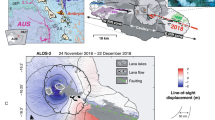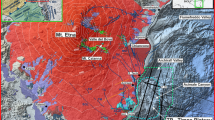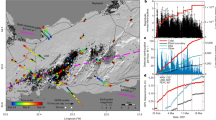Abstract
The 2011 Mw 9.0 Tohoku earthquake caused an unprecedented level of crustal deformation in eastern parts of Japan1,2,3. The event also induced seismic activity in the surrounding area, including some volcanic regions4,5, but has not yet triggered any eruptions. Here we use data from satellite radar and the Global Positioning System to show that volcanic regions, located between 150 and 200 km from the rupture area6, experienced subsidence coincident with the Tohoku earthquake. The volcanic regions subsided by 5–15 cm, forming elliptical depressions with horizontal dimensions of up to 15–20 km. The depressions are elongated in a direction roughly perpendicular to the axis of maximum coseismic extension. A high concentration of Late Cenozoic calderas7, high heat flow8, hot thermal waters9, and young and hot granite10 in the subsided regions imply the presence of magmatic and hot plutonic bodies beneath the volcanoes, that may have deformed and subsided in response to stress changes associated with the Tohoku earthquake along with the surrounding, thermally weakened host rocks. Similar subsidence observed in Chile following the 2010 Maule earthquake11 indicates that earthquake-triggered subsidence could be widespread in active volcanic chains along subduction zones.
This is a preview of subscription content, access via your institution
Access options
Subscribe to this journal
Receive 12 print issues and online access
$259.00 per year
only $21.58 per issue
Buy this article
- Purchase on Springer Link
- Instant access to full article PDF
Prices may be subject to local taxes which are calculated during checkout




Similar content being viewed by others
Change history
16 July 2013
In the version of this Letter originally published online, the published online date was incorrect; it should have read 1 July 2013. This has been corrected in all versions of the Letter.
References
Sato, M. et al. Displacement above the hypocentre of the 2011 Tohoku-Oki earthquake. Science 332, 1395 (2011).
Takahashi, H. Static strain and stress changes in eastern Japan due to the 2011 off the Pacific coast of Tohoku Earthquake, as derived from GPS data. Earth Planets Space 63, 741–744 (2011).
Ozawa, S. et al. Coseismic and postseismic slip of the 2011 magnitude-9 Tohoku-Oki earthquake. Nature 475, 373–377 (2011).
Coordinating Committee for Prediction of Volcanic Eruption, Report issued at the 120th meeting of the committee, 7 June 2011 (http://www.seisvol.kishou.go.jp/tokyo/STOCK/kaisetsu/CCPVE/shiryo/120/120_no05.pdf, in Japanese) (2011).
Yukutake, Y. et al. Remotely-triggered seismicity in the Hakone volcano following the 2011 off the Pacific coast of Tohoku Earthquake. Earth Planets Space 63, 737–740 (2011).
Yagi, Y. & Fukahata, Y. Rupture process of the 2011 Tohoku-oki earthquake and absolute elastic strain release. Geophys. Res. Lett. 38, L19307 (2011).
Yoshida, T. The evolution of arc magmatism in the NE Honshu arc, Japan. Sci. Rep. Tohoku Univ. 36, 131–149 (2001).
Tanaka, A., Yamano, M., Yano, Y. & Sasada, M. Geothermal gradient and heat flow data in and around Japan (I): Appraisal of heat flow from geothermal gradient data. Earth Planets Space 56, 1191–1194 (2004).
Geological Survey of Japan, Distribution map and catalogue of hot and mineral springs in Japan [CD-ROM], (in Japanese with English abstract., 2nd edn, Digital Geosci. Map GT-2, Natl Inst. of Adv. Ind. Sci. and Technol., Tsukuba, Japan) (2005).
Doi, N. et al. Genesis of the plutonic-hydrothermal system around Quaternary granite in the Kakkonda geothermal system, Japan. Geothermics 27, 663–690 (1998).
Pritchard, M. E., Jay, J. A., Aron, F., Henderson, S. T. & Lara, L. Subsidence at southern Andes volcanoes induced by the 2010 Maule, Chile earthquake. Nature Geosci. http://dx.doi.org/10.1038/ngeo1855 (2013).
Simons, M. et al. The 2011 magnitude 9.0 Tohoku earthquake: Mosaicking the megathrust from seconds to centuries. Science 332, 1421–1425 (2011).
Ito, T., Ozawa, K., Watanabe, T. & Sagiya, T. Slip distribution of the 2011 off the Pacific coast of Tohoku Earthquake inferred from geodetic data. Earth Planets Space 63, 627–630 (2011).
Yamazaki, Y., Lay, T., Cheung, K. F., Yue, H. & Kanamori, H. Modeling near-field tsunami observations to improve finite-fault slip models for the 11 March 2011 Tohoku earthquake. Geophys. Res. Lett. 38, L00G15 (2011).
Nishimura, T., Munekane, H. & Yarai, H. The 2011 off the Pacific coast of Tohoku Earthquake and its aftershocks observed by GEONET. Earth Planets Space 63, 631–636 (2011).
Yoshida, T. et al. Evolution of Late Cenozoic magmatism in the NE Honshu arc and its relation to the crust–mantle structures. (in Japanese with English abstract and figure legend). Quat. Res. 44, 195–216 (2005).
Cayol, V. & Cornet, F. H. 3D mixed boundary elements for elastostatic deformation field analysis. Int. J. Rock Mech. Min. Sci. 34, 275–287 (1997).
Gamerman, D. Markov Chain Monte Carlo: Stochastic Simulation for Bayesian Inference (Chapman and Hall/CRC, 1997).
Améglio, L. & Vigneresse, J. L. in Understanding Granites: Integrating New and Classical Techniques Vol. 168 (eds Castro, A., Fernandez, C. & Vigneresse, J. L.) 39–54 (Geol. Soc. Lond. Spec. Pub., 1999).
Petford, N., Cruden, A. R., McCaffrey, K. J. W. & Vigneresse, J. L. Granite magma formation, transport and emplacement in the Earth’s crust. Nature 408, 669–673 (2000).
Onodera, M., Horiuchi, S. & Hasegawa, A. Three-dimensional seismic velocity structure in and around the focal area of the 1996 Onikobe Earthquake based on V p/V s inversion. (in Japanese with English abstract and figure legend). J. Seismol. Soc. Jpn 51, 265–279 (1998).
Zhao, D., Wang, Z., Umino, N. & Hasegawa, A. Mapping the mantle wedge and interplate thrust zone of the northeast Japan arc. Tectonophysics 467, 89–106 (2009).
Zhao, D., Huang, Z., Umino, N., Hasegawa, A. & Yoshida, T. Seismic imaging of the Amur-Okhotsk plate boundary zone in the Japan Sea. Phys. Earth Planet. Inter. 188, 82–95 (2011).
Takada, Y. & Furuya, M. Aseismic slip during the 1996 earthquake swarm in and around the Onikobe geothermal area, NE Japan. Earth Planet. Sci. Lett. 290, 302–310 (2010).
Abe, T., Furuya, M. & Takada, Y. Nonplanar fault source modelling of the 2008 M w 6.9 Iwate-Miyagi Inland Earthquake in Northern Japan. Bull. Seism. Soc. Am. 103, 507–518 (2013).
Tsuji, Y., Nakajima, J. & Hasegawa, A. Tomographic evidence for hydrated oceanic crust of the Pacific slab beneath northeastern Japan: Implications for water transportation in subduction zones. J. Geophys. Res. 35, L14308 (2008).
Cheng, C.H. & Johnston, D.H. Dynamic and static moduli. Geophys. Res. Lett. 8, 39–42 (1981).
Wessel, P. & Smith, W.H.F. New, improved version of Generic Mapping Tools released. EOS Trans. Amer. Geophys. U 79, 579 (1998).
Acknowledgements
We thank T. Yoshida, M. Pritchard, K. Ishihara and M. Hashimoto for discussions. We thank Y. Ohta for assistance in analysis of GPS data. The PALSAR level 1.0 data were provided by the Japan Aerospace Exploration Agency (JAXA) via the Geospatial Information Authority of Japan as part of the project ‘Evaluation of Use of Advanced Land Observation Satellite for Disaster Mitigation’ of the Earthquake Working Group and via the PALSAR Interferometry Consortium to Study our Evolving Land surface (PIXEL) based on a cooperative research contract between JAXA and the Earthquake Research Institute, the University of Tokyo. The PALSAR product is owned by JAXA and the Ministry of Economy, Trade and Industry, Japan. We used Generic Mapping Tools28 to prepare illustrations. This work was supported by MEXT/JSPSGrant-in-Aid for Young Scientists (B)24740305 to Y.T.
Author information
Authors and Affiliations
Contributions
Y.T. and Y.F. contributed equally to the work presented in this paper. Y.T. analysed the SAR images and GPS data. Y.F. analysed the SAR images and conducted the model calculations. Both authors discussed the significance of interferometry and the interpretation of the geodetic inversion.
Corresponding author
Ethics declarations
Competing interests
The authors declare no competing financial interests.
Supplementary information
Supplementary Information
Supplementary Information (PDF 3098 kb)
Rights and permissions
About this article
Cite this article
Takada, Y., Fukushima, Y. Volcanic subsidence triggered by the 2011 Tohoku earthquake in Japan. Nature Geosci 6, 637–641 (2013). https://doi.org/10.1038/ngeo1857
Received:
Accepted:
Published:
Issue Date:
DOI: https://doi.org/10.1038/ngeo1857
This article is cited by
-
Heterogeneous rheology of Japan subduction zone revealed by postseismic deformation of the 2011 Tohoku-oki earthquake
Progress in Earth and Planetary Science (2023)
-
Magmatic connectivity among six Galápagos volcanoes revealed by satellite geodesy
Nature Communications (2023)
-
Spatiotemporal functional modeling of postseismic deformations after the 2011 Tohoku-Oki earthquake
Earth, Planets and Space (2022)
-
Magma reservoir beneath Azumayama Volcano, NE Japan, as inferred from a three-dimensional electrical resistivity model explored by means of magnetotelluric method
Earth, Planets and Space (2021)
-
Consistent estimation of strain-rate fields from GNSS velocity data using basis function expansion with ABIC
Earth, Planets and Space (2021)



